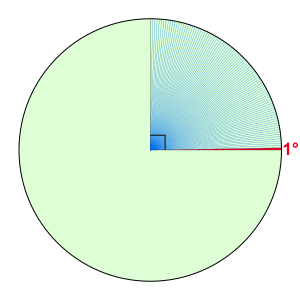Degree (angle) facts for kids
Quick facts for kids Degree |
|
|---|---|

One degree (shown in red) and 89 degrees (shown in blue)
|
|
| General information | |
| Unit system | Non-SI accepted unit |
| Unit of | Angle |
| Symbol | ° or deg |
| Conversions | |
| 1 ° in ... | ... is equal to ... |
| turns | 1360 turn |
| radians | π180 rad |
| gons | 109g |
A degree is a special way to measure how wide an angle is. You'll often see it written with a little circle symbol, like  . Imagine a full circle; that's
. Imagine a full circle; that's  !
!
Even though the SI system (the main system for measurements) usually uses something called a radian for angles, the degree is still a very common and accepted way to measure them.
History of the Degree
Why do we use 360 degrees for a circle? No one knows for sure, but there are a few interesting ideas!
The 360-Day Year
One idea is that it's connected to the number of days in a year. Long ago, some ancient calendars, like the Persian calendar and the Babylonian calendar, counted about 360 days in a year. It makes sense that people might have linked the full circle of a year to the full circle of an angle.
Babylonian Influence
Another theory points to the ancient Babylonians. They were very good at math! It's thought they might have divided a circle using the angle of an equilateral triangle. An equilateral triangle has three equal sides and three equal angles, each being 60 degrees.
The Babylonians then divided this 60-degree angle into 60 smaller parts. This is because they used a special number system called a base-60 system. It's like how we use a base-10 system (counting by tens), but they counted by sixties! This system helped them create the 360-degree circle.
Related Pages
See also
 In Spanish: Grado sexagesimal para niños
In Spanish: Grado sexagesimal para niños

